
USHIO INC. and Consolidated Subsidiaries
Year ended March 31, 2016
The USHIO Group—comprising the parent company, 57 consolidated subsidiaries and 2 equity-method affiliates—engages mainly in manufacturing and marketing light sources, equipment, and machinery for industrial uses. The Group also engages in research and development and provides other services related to its businesses.
In the fiscal year ended March 31, 2016, the U.S. economy saw a gradual recovery supported by an increase in personal spending and improving employment conditions. Meanwhile, the Chinese economy continued to decelerate and other developing countries remained under pressure, mainly owing to the impact of a drop in crude oil prices. In Japan, although corporate earnings and employment conditions showed signs of improvement, personal spending was sluggish.
In the cinema-related markets, which are key markets for the USHIO Group's imaging equipment and light sources, the number of screens continues to increase in developing markets, including China.
In the electronics market, a key market for the USHIO Group's optical equipment and light sources, demand increased for electronic components and small and medium-sized LCD panels for high-end smartphones.
Under these economic conditions, the USHIO Group took steps to bolster Group-wide synergies, including expanding visual imaging business solutions. In addition, the Group actively executed R&D investments in new technologies and products for the future, in fields such as the science and biomedical businesses.
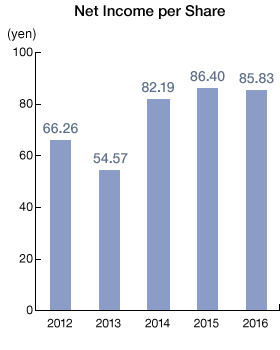
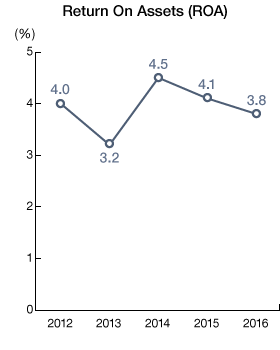
During the fiscal year ended March 31, 2016, both sales and income increased.
Consolidated net sales increased 12.4% year on year to ¥179,121 million. In the equipment business, in addition to the foreign exchange impact, sales increased mainly due to increased sales in the visual imaging business. In the light sources business, in addition to the foreign exchange impact of the yen's depreciation against the dollar, sales increased mainly due to increased sales of xenon lamps for digital cinema projectors, and of solid state light sources.
Operating income rose by 26.8% year on year to ¥13,130 million. The improvement was attributable to steady growth both in the equipment and light sources businesses.
Ordinary income rose 6.7% year on year to ¥14,633 million. This increase mainly reflected the foreign exchange impact of the yen's depreciation against the dollar, which was partially offset by investment losses on stock held.
Net income attributable to owners of parent declined 1.5% to ¥11,105 million, mainly due to the posting of an extraordinary loss from the expenses of moving the Head Office.
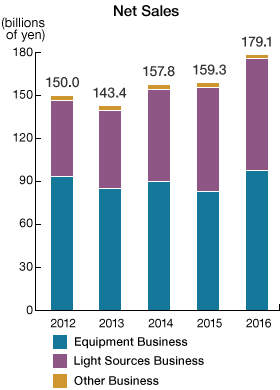
The equipment business saw sales increase 17.4% year on year to ¥98,828 million, recording segment income of ¥1,726 million.
In the imaging equipment sub‒segment of the business, in the cinema field, sales in the cinema-related business increased, mainly due to increased adoption of laser projectors, in addition to higher shipments of digital cinema projectors supported by the continuing installation of new cinema screens, primarily in newly developing countries, including China. In general imaging equipment, the USHIO Group posted higher sales of imaging equipment for entertainment, primarily amusement parks and various events, mainly due to the launch of new products. Combined with a boost from the yen's depreciation, profit increased for the imaging equipment sub-segment as a whole.
In the optical equipment sub-segment, solid demand primarily for high-end smartphones, among other factors, led to an increase in sales of projection lithography equipment for related electronic devices. Meanwhile, there were signs of restrained capital investment in smartphones in the middle and lower price ranges primarily in the Chinese market, leading to lackluster demand for lithography equipment for PCBs. In addition, in the LCD-related market, sales of optical alignment equipment for high-definition LCD panels for mobile devices increased on the back of continuing demand for high-resolution small and medium-sized LCD panels. Consequently, profit increased for the optical equipment sub-segment as a whole.
Sales in the light sources business increased by 7.6% year on year to ¥78,574 million. Segment profit was up by 9.0% year on year to ¥10,976 million.
The light sources business posted higher sales and profit, aided significantly by the foreign exchange impact of the weaker yen against the dollar.
Among discharge lamps, UV lamps for lithography saw lower sales mainly due to continuing growth in the use of long-life types both in the semiconductor and LCD equipment fields, along with the impact of price competition, although earnings were lifted by the impact of the yen's depreciation. Meanwhile, xenon lamps for digital cinema projectors posted higher sales, despite the impact of price competition. This result was mainly due to a continuing increase in the total number of digital cinema projectors in newly developing markets, including China, along with a boost from the yen's depreciation. In solid state light sources, sales increased due to M&A-driven growth in the semiconductor laser and LED businesses, in addition to expansion in demand for laser light sources for projectors.
Halogen lamps posted lower sales, mainly as lamps for office automation equipment were impacted by lackluster economic conditions in developing countries, although sales were lifted by the impact of the yen's depreciation.
Sales in other businesses decreased by 5.7% year on year to ¥3,218 million and segment profit increased by 3.5% year on year to ¥181 million.
In other businesses, the USHIO Group posted sluggish sales of products such as die-casting inspection equipment, despite firm sales of plastic molding machines.
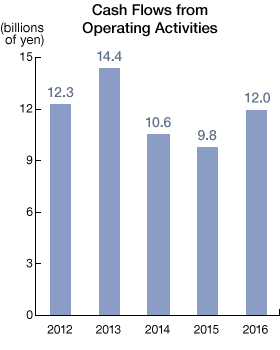
Cash and cash equivalents on March 31, 2016 totaled ¥47,813 million, down ¥9,176 million from the previous fiscal year‒end. Cash flows are broken down as follows:
Operating activities in the fiscal year ended March 31, 2016 provided net cash of ¥12,031 million (compared with net cash of ¥9,876 million provided in the previous year). The main positive contributions to this result were ¥15,187 million in income before income taxes and minority interests, and a ¥6,495 million adjustment for depreciation and amortization. Meanwhile, factors reducing cash included a ¥1,075 million loss on sales of non-current assets, an ¥8,108 million increase in inventories and income taxes paid of ¥4,349 million.
Investing activities used net cash of ¥10,367 million (compared with net cash used of ¥3,710 million in the previous fiscal year). The main factors increasing cash were proceeds from withdrawal of time deposits of ¥15,432 million, proceeds from sales and redemption of securities of ¥7,248 million and proceeds from sales of property, plant and equipment of ¥1,953 million. The main factors decreasing cash were an increase in time deposits of ¥13,766 million, purchase of securities of ¥3,940 million, purchase of property, plant and equipment of ¥7,903 million, purchase of investment securities of ¥6,134 million, and purchase of shares of subsidiaries resulting in change in scope of consolidation of ¥3,883 million.
Financing activities used net cash of ¥7,849 million (compared with ¥1,210 million provided in the previous fiscal year). The main factor increasing cash was proceeds from long-term debt of ¥1,212 million. Against this, factors decreasing cash included repayment of long‒term debt of ¥1,373 million, purchase of treasury stock of ¥3,177 million, cash dividends paid totaling ¥3,133 million and payments from changes in ownership interests in subsidiaries that do not result in change in scope of consolidation of ¥1,415 million.
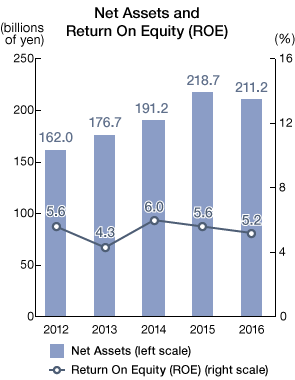
At the fiscal year‒end, assets totaled ¥294,525 million, a decrease of ¥16 million from the previous fiscal year‒end. The main factors behind this decrease were decreases in cash and deposits mainly due to the purchase of treasury shares, and securities due to the sale of bond investment trusts and other securities.
The main factors increasing total assets were increases in inventories in line with higher business volume, goodwill associated with M&A activity, and investment securities due to the purchase of bonds.
At the fiscal year‒end, liabilities totaled ¥83,228 million, an increase of ¥7,410 million from the previous fiscal year‒end. The main factors behind this increase were increases in short‒term loans payable to meet demand for working capital and net defined benefit liability due to changes in the discount rate and other parameters.
At the fiscal year‒end, net assets totaled ¥211,296 million, a decrease of ¥7,427 million from the previous fiscal year‒end. The main factors behind this decrease were decreases in foreign currency translation adjustments due to a stronger yen, and re-measurements of defined benefit plans due to a change in the discount rate, along with an increase in treasury stock due to the purchase of treasury stock.
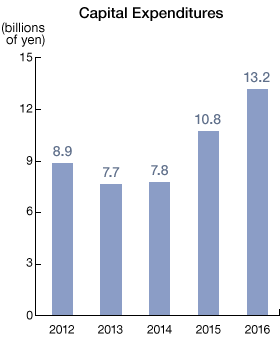
The USHIO Group's capital expenditures for the fiscal year ended March 31, 2016 were ¥13,224 million. The bulk of this expenditure was for capital investment in the light sources and equipment businesses, with investments focused on building up existing facilities, as well as on businesses promising growth in future, and research and development. A breakdown of capital expenditures for the fiscal year was as follows. (Figures are calculated on an acceptance basis for property, plant and equipment, intangible fixed assets, and long-term prepaid expenses. Amounts do not include consumption tax or other levies.)
| 2016 | YoY Change | |
|---|---|---|
| Light sources business | ¥5,870 million | 164.9% |
| Equipment business | ¥6,871 million | 101.8% |
| Other businesses | ¥481 million | 82.5% |
| Total capital expenditures | ¥13,224 million | 121.3% |
Capital expenditures increased in the fiscal year ended March 31, 2016. This reflected the fact that in every segment the Group continued to make key investments aimed at strengthening the Group's operational competitiveness in potential growth fields, while selecting investments rigorously and focusing on capital efficiency.
The USHIO Group's investments focused mainly on the equipment and light sources businesses. In the equipment business, the Group focused its expenditure on optical equipment including lithography equipment and optical processing equipment targeting diversifying market needs, as well as laser projectors and sound systems in visual imaging fields, and simulation systems and virtual reality in general imaging fields. In the light sources business, the Group focused primarily on expenditure to maintain its high quality and technological advantages and to expand its solid state light sources (LEDs and laser diodes) business.
The Group funded its capital expenditures with a combination of internally generated funds and borrowings.
Loss on disposal of plant, property and equipment was ¥226 million, due to the disposal of plant facilities such as buildings and machinery in the light sources and equipment businesses.
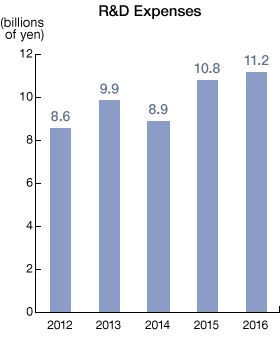
Group‒wide R&D expenses totaled ¥11,228 million. Most of this was spent in the light sources and equipment businesses. The main targets of the Group's R&D were light sources for industrial applications for development and production, which included work use and application of optical applications in electronic and electromechanical equipment, moving ahead with development of indispensable peripheral technologies and development for commercialization of optical units, optical equipment and systemization. The Company stepped up its efforts to keep abreast of the latest developments in markets and technology and conducted strategic R&D activities. It is organized in a way that enables interaction among the R&D teams from different product groups to encourage development of new kinds of light sources and equipment. R&D expenses in every segment include inter-segment transactions.
The USHIO Group's key achievements during the fiscal year ended March 31, 2016 were as follows:
Our subsidiary USHIO OPTO SEMICONDUCTORS, INC. developed a red laser diode for use in the industrial measurement field and head-up displays where future growth is anticipated. The product features a transverse mode to produce a single peak beam, a wavelength of 638 nm, and output power of 200 mW. It is world-class among single transverse mode laser diodes in this wavelength range. Further, this subsidiary is working to develop a red laser diode with high output power for use as a solid state light source in cinema and industrial projectors. It is developing a product with a wide luminescence band and vast output power to the tune of 1.2 W or 2 W, targeting commercialization in the fiscal year ending March 31, 2017.
Our subsidiary ADTEC Engineering Co., Ltd. fully leveraged its technology in direct imaging exposure systems for patterning to develop a direct imaging exposure system for solder resist. The system uses semiconductor laser diodes of two wavelengths—375nm and 405nm—for a light source, enabling the wavelength ratio to be changed. This allows for the light source to be matched to the best spectral sensitivity for resist, giving each user the ability to optimally adjust solder resist qualities (resolution, cross-section shape, rigidity, etc.) to differing processes. Further, the product employs a magnifying optical system using an optical microlens array to deliver high definition and wide exposure area, enabling single pass exposure. By using two light source wavelengths and a microlens array magnifying optical system, the product realizes both high resolution with diameters up to 50 µm and high productivity of 60 seconds at 200 mJ.
Our subsidiary CHRISTIE DIGITAL SYSTEMS CANADA INC. developed the world's first digital light processing (DLP) projector to achieve a stunning contrast ratio of 1,000,000:1. That is a huge advancement over the 2,500:1 contrast ratio for the latest conventional digital cinema projector models. DLP projectors made it possible to multiply the normally attainable contrast ratios of about several thousand to one due to the optical characteristics of imaging devices by putting one more imaging device into the optical system to be used as a backup for modulation. Moreover, these projectors realize high contrast by aligning imaging devices in rows and connecting the two optical engines to relay lenses. This development makes the bright parts of images brighter and the dark parts darker, and realizes crisp images down to the finest details throughout the bright to dark spectrum to create even more realistic images.
Looking at the USHIO Group's business climate, the electronics sector is likely to see ongoing capital expenditures in the LCD field led by China, whereas smartphone market growth looks set to slow. In small- and medium-sized LCD panels, organic EL uptake is expected to advance chiefly in high-end models. Turning to semiconductors, an increase in data centers as the IoT advances and there are increasingly sophisticated smartphones, and rising demand for lithography equipment driven by growing automotive and infrastructure investment are anticipated. Also for the electronics industry overall, end users are quite interested in enhancing cost effectiveness and long life-type light sources continue to gain ground.
In the cinema area of visual imaging fields, the annual number of new digital cinema screen installations is expected to keep rising, led by China and other emerging countries. On the other hand, flat sales of digital cinema projectors are anticipated in developed countries where the annual pace of new installations is decelerating since the shift to digital screens has already made substantial headway. Turning to the general imaging field, opportunities to utilize images for industrial and entertainment purposes are expected to keep growing in the future.
The Group will address these developments in its business environment and markets—the major priorities are to accelerate its development of new products and entry into new fields, and to improve profitability. To implement these priorities, the Group will expand its operations by making active strategic investments to develop new products, find new applications for its products, and launch new products and businesses. The Group will also enhance its product lineup to respond to diversifying market needs, reduce manufacturing costs throughout its operations, and improve quality and productivity. In addition, the Group will endeavor to expand and reinforce its manufacturing bases as well as its sales bases and networks both in Japan and overseas. In doing so, it aims to optimize its service structure and develop a more proposal-oriented total-solution type business to expand its sales of light sources, optical equipment, and imaging equipment to global markets. The Group will not limit itself to in-house development, but will also seek to develop dynamic businesses by considering business partnerships, investments, or other options.
The USHIO Group regards environmental issues as a key management concern in terms of corporate social responsibility, and will continue to take active steps to save energy and resources, cut waste, increase recycling, and otherwise reduce its environmental footprint. Meanwhile, the Group will continue with measures to ensure that it merits the trust of all its stakeholders. These will involve optimizing its internal control systems by bolstering corporate governance and compliance, and ensuring continued stability in its operations by putting in place the best possible provision for risk management including business continuity planning.
Below is a summary of risks that could affect the USHIO Group's business performance, financial position, and cash flow adversely and materially.
These are the risks cited by management in the Group's Yukashoken Hokokusho (Annual Securities Report) to the Japanese government, filed on June 29 2016. This is only a partial listing, and the Group faces risks other than those cited here that could also affect its business performance, financial position, and cash flow materially.
The Group’s business performance is affected by fluctuations in demand in the semiconductor and LCD industries. Currently, the USHIO Group’s product line includes lamps for manufacturing equipment. These products are consumables, and demand for these lamps is generally steady as long as customer plants are operating. However, the semiconductor and LCD manufacturing equipment the Group handles is affected by changes in demand for products in the short‒term and the medium‒to‒long‒term, as well as by technological developments, which can materially affect the Group’s business performance and financial position.
In addition to the semiconductor and LCD panel fields, the Group supplies light sources that are included in data projectors and digital cinema projectors and for illumination. Trends in technology and fluctuations in prices and demand for these light sources could materially affect the Group’s business performance and financial position.
The Group supplies cinema projectors and large projectors for business use. Fluctuations in demand in business areas, technical trends in the market, and fluctuations in prices could have a material impact on the Group’s business performance and financial position.
The Group relies on externally sourced raw materials that it obtains from a broad range of suppliers to ensure the steady supply of high-quality materials at stable prices. In particular, rare metals such as tungsten and molybdenum and special glass are the essential raw materials for manufacturing lamps. Supply shortages or price increases of these materials may boost manufacturing costs and materially affect the Group’s business performance and financial position.
The Group conducts manufacturing and sales activities in regions outside Japan such as other Asian nations, North America, and Europe. Entry into these overseas markets is accompanied by potential risks in each country, such as changes in various rules and regulations, instability in securing human resources, underdeveloped infrastructure, and social unrest. If realized, these risks could materially affect the Group’s business performance and financial position.
The Group operates in business sectors characterized by frequent technological advances. Protecting, maintaining, and managing patents, trademarks, and other intellectual property are key factors to remaining competitive and maintaining a market share in those business sectors. Litigation could arise if a third party were to infringe on the Group's intellectual property rights, or if the Group were to infringe on a third party's intellectual property rights. In addition, the patent authorities could refuse patent applications submitted by the Group. Events such as these which would significantly comprise the Group's protection of its intellectual property rights, could affect the Group's business performance and financial position materially.
The Group conducts its commercial and financial operations such as investments and loans in yen and in other currencies. Profits and losses in the Group's commercial and financial operations conducted in foreign currencies are subject to the influence of fluctuations in currency exchange rates. The Group uses forward exchange contracts to moderate currency exchange risk, but it cannot negate this risk completely. Fluctuations in the foreign exchange rates could therefore materially affect the Group's business performance and financial position.
The Group holds marketable securities as financial assets. Depending on stock market and other conditions, the fair value of these securities could decline. Therefore, the Group is exposed to the risk of fluctuations in the prices of marketable securities, which could affect the Group's business performance and financial position materially.
There are no important contracts to report.